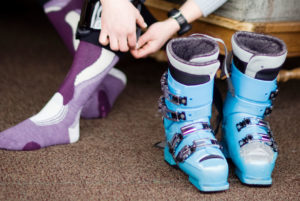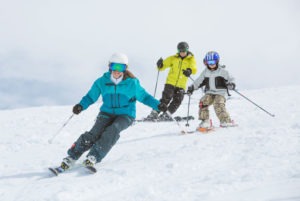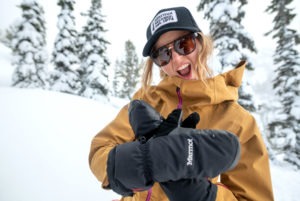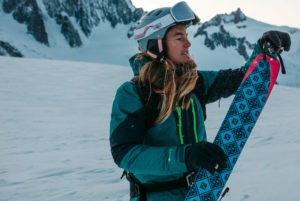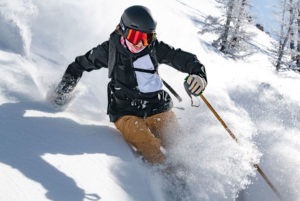
Outdoor clothing technology is rapidly changing with each season. Just when you think your battery operated thermal jacket is the best purchase ever, a lighter weight body heat reflective liner comes out. And when you dive in to do some research on your own, you’re frustrated by a language of acronyms! Well, you shouldn’t have to work in the outdoor clothing industry to know what all this fabric, treatment and material jargon means. We’ve provide you with a thorough fabric glossary so you can understand what product descriptions actually mean! Once you review it, cruise on back to The House’s men’s jackets and women’s jackets to put your new fabric deciphering skills to the test.
- Breathable – Fabric with the ability to allow sweat vapors to move from the inside of the jacket to the outside.
- Canvas – A strong, durable, closely woven cotton fabric.
- Chambray – A plain woven fabric that can be made from cotton, silk or manufactured fibers. However, it is most commonly cotton. Chambray incorporates a colored warp (often blue) and white filling yarns.
- Coated – Fabrics that are coated with urethane on the outside for water resistance.
- Cotton – A white vegetable fiber grown in warmer climates in many parts of the world, cotton has been used to produce many types of fabric for hundreds of years. Cotton fabric feels nice against the skin regardless of the temperature or the humidity and is therefore in great demand by consumers.
- Denier – The mass of a strand of yarn. One unit of yarn number is equal to the weight in grams of 9,000 meters of yarn. The thicker the thread, the higher the denier, the heavier the fabric.
- Dobby – A decorative weave, characterized by small figures or patterns (usually geometric) that are woven into the
 fabric structure.
fabric structure. - Domestic – Made in the USA.
- Double Knit – A weft knit fabric in which two layers of loops are formed that cannot be separated. A double knit machine with two complete sets of needles is required for this fabric construction.
- DWR – Stands for durable water repellent. It typically refers to water repellent coatings that force the water to bead up on fabrics, thereby preventing saturation.
- Embossing – A calendering process in which fabrics are engraved with the use of heated rollers under pressure to produce a raised design on the fabric surface.
- Embroidery – An embellishment of a fabric or garment in which colored threads are sewn on to the fabric to create a design. Embroidery may be done either by hand or machine and is often used for brand logos.
- Faux Fur – Artificial fur made from synthetic material.
- Face Fabric – The outside surface of the fabric.
- Flannel – Typically, a 100% cotton fabric that has been brushed on one or both sides for softness. It is sometimes used as lining in outdoor apparel.
- Fleece – Soft synthetic fabric made from Polyethylene terephthalate (PET) or other synthetic fibers that stretches across the grain. It is often used for jackets, vests, linings and performance shirts.
- Gingham – A medium weight, plain weave fabric with a plaid or check pattern.
- Gore-Tex® – Gore-Tex® is a waterproof/breathable registered trademarked fabric. Countless brands incorporate Gore-Tex into their garments. Trusted and proven for years, Gore-Tex® fabrics are created by laminating a Gore-Tex® membrane to high performance textiles, followed by a sealed treatment of a waterproofing agent.
- Hand – Feel of a fabric.
- Herringbone – A variation on a twill weave construction in which the twill is reversed, or broken, at regular intervals, thereby producing a zig-zag effect. Herringbone is often found on outerwear.
- Import – Made outside of the USA.
- Jacquard – Woven fabrics manufactured by using the Jacquard attachment on the loom. This attachment
 provides versatility in designs and permits individual control of each of the warp yarns. Thus, fabrics of almost any type or complexity can be made. There is typically and up charge for outerwear featuring a jacquard.
provides versatility in designs and permits individual control of each of the warp yarns. Thus, fabrics of almost any type or complexity can be made. There is typically and up charge for outerwear featuring a jacquard. - Laminate – Fabric constructed of layers laminated together, as in a waterproof-breathable laminate.
- Loft – The depth of a fabric.
- Lycra – A DuPont trademark for its spandex fiber. Lycra is comfortable, allows free range of movement and retains shape that won’t wash away.
- Mesh Lining – Holds less moisture than other types of lining. Many times you will see taffeta and micro-mesh combined in RTW (ready to wear) garments, with taffeta on the sleeves and below the powder skirt and micro-mesh in the body of the item.
- Microfiber – Fabric made of synthetic yarns of less than one denier per filament.
- Moleskin – Resists wrinkling and has a beautiful sueded look on the face. The reverse has a satiny look and feel. Generally, moleskin will contain 2-4% spandex. It is popular for pants, jackets and heavy shirts.
- Nylon – The first completely synthetic fiber developed. Known for its high strength and excellent resilience, nylon has superior abrasion resistance and high flexibility.
- Oxford – Fabric with a small basket weave (2 x 1), a fine warp and and coarse fill.

- Ply – Typically refers to how many yarns make up a thread. A fabric made of 3-ply thread will be stronger than one made of 2-ply thread. Ply is sometimes used to refer to how many layers are in laminated or waterproof/breathable fabrics.
- Polypropylene – A synthetic Olefin fiber made from propylene.
- Polyester – Man-made fiber made of synthetic polymers.
- Preload – Referring to cordlocks, the hole is held open until you release it.
- Rayon – A natural fiber created from wood pulp. It usually has good drape and a soft hand. It’s often used for tops, shirts, skirts and dresses.
- Sealcoat – Fabric that has multiple layers of urethane coating making it heat sealable.
- Spandex – A manufactured elastomeric fiber that can be repeatedly stretched over 500% without breaking. Even after stretching, it will still recover to its original length.
- Supplex – A Dupont trademark for one of several textured nylons (not Taslan, however). It is a very high filament yarn (66 filaments per yarn) that is “air-dried” to give it an incredibly soft texture.
- Taffeta – A plain weave fabric (1 x 1) that is smooth on both sides. Nylon taffeta is commonly used for linings and windbreakers.
- Taslan – A fiber process used generically to describe a type of texture. The Taslan process of “air-drying” nylon filaments is applied to heavier yarns to create a soft fabric.
- Thread Count – Number of threads per inch.
- Tricot Knit – Flexible knitted fabric.

- Tweed – A medium to heavy weight, fluffy, woolen, twill weave fabric containing colored slubbed yarns. Tweed is a fashion forward look on outerwear.
- Twill – A fabric that shows a distinct diagonal wale on the face (as in denim).
- Waterproof/Breathable – Refers to any fabric with a PTFE (polytetrafluoroethylene) coating laminated to the inside, that both repels water and moves moisture and vapor from the inside to the outside. Gore-tex® is the most known of these types of fabrics although many brands have developed their own line of fabrics with the same or similar properties.
Comment below if you feel we’ve missed something and we’ll add to this list asap.


